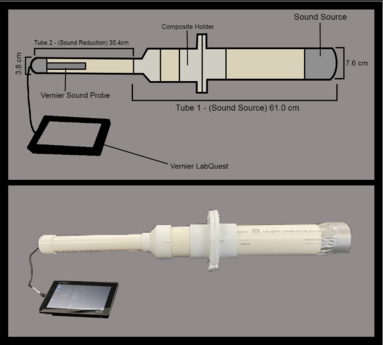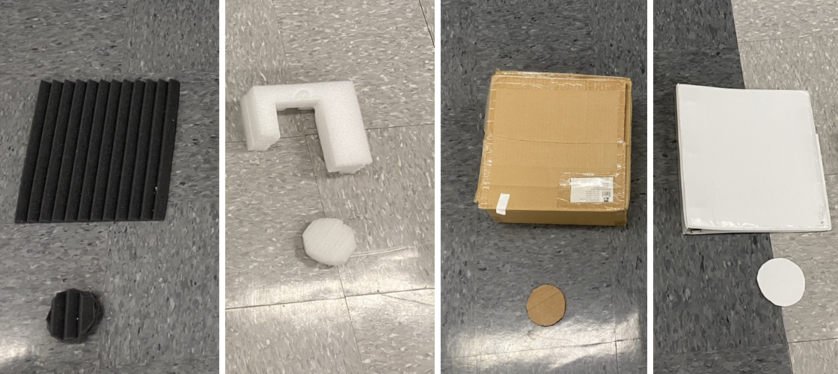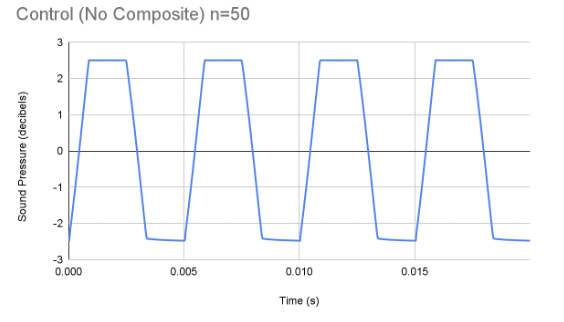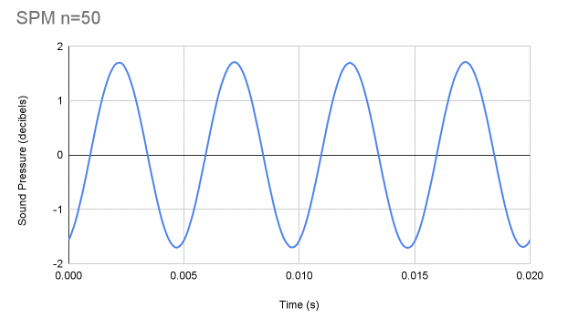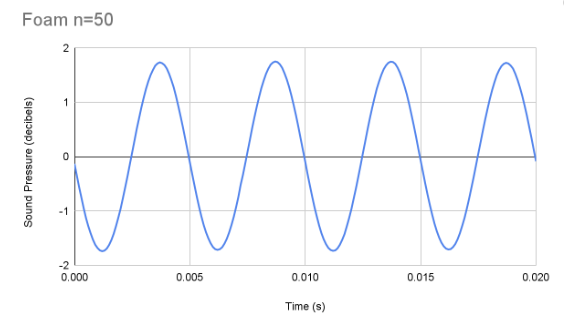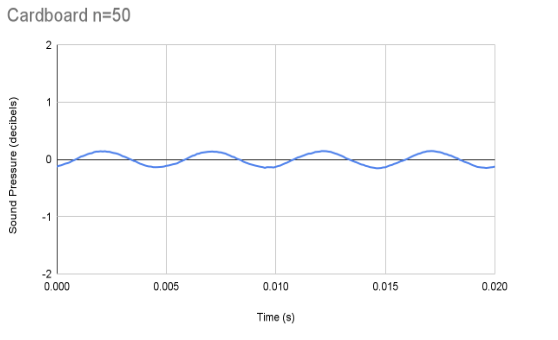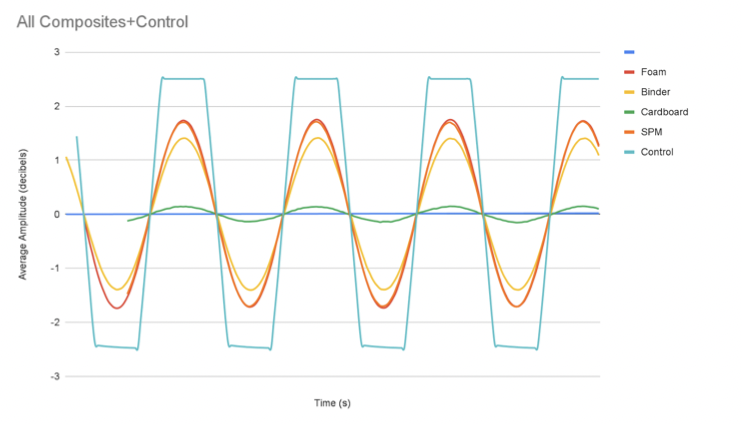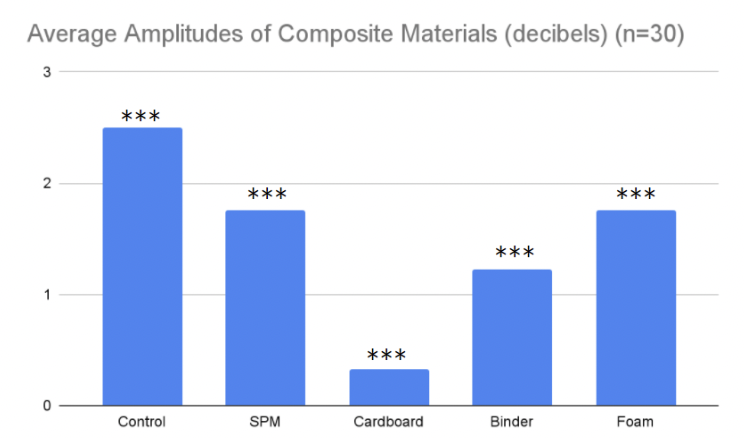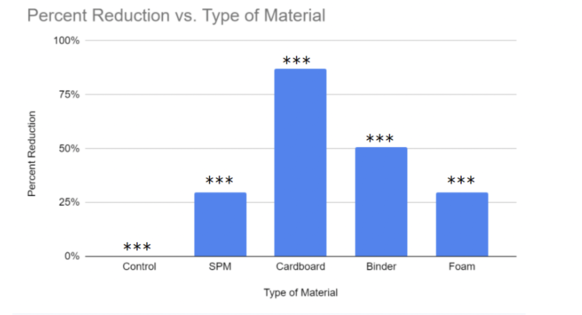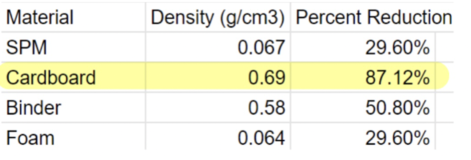Zachary.rho (talk | contribs) |
Zachary.rho (talk | contribs) |
||
| Line 40: | Line 40: | ||
| − | [[File: | + | [[File:Review_667457076814_8101_838px-Review_667457076814_7649_Screen_Shot_2023-07-31_at_9.10.23_PM.png]] |
Figure 2: Recyclable Materials Used | Figure 2: Recyclable Materials Used | ||
Revision as of 15:43, 10 August 2023
Abstract
In today’s world, the rate of urbanization is increasingly getting faster and faster. Large cities that are heavily populated produce noise that is not only harmful to one’s hearing, but also for concentration and productivity. If constantly exposed to an environment such as the ones existing in heavily populated cities, long-term effects will take place in the health of citizens such as damage to the cochlea membrane, increased progression of hearing loss, and long-term nerve damage within the ear canal. Furthermore, there is an average of 292.4 million tons of waste being produced on average since the year 2018. Approximately 50% of materials being thrown out are materials that can be recycled or repurposed. Using recyclable materials to create an effective yet affordable soundproofing composite would be important from a health, economic and environmental standpoint. Recyclable materials (foam, cardboard, binder, soundproofing material) were tested for their soundproofing capabilities using a self-constructed low-cost impedance tube. A bluetooth speaker was used to produce a consistent frequency of sound (400 Hz) for 5 seconds into a composite. A Vernier SoundProbe was utilized to measure the sound after passing through the composite in decibels. The average amplitude (decibels) without any composite was 2.5 while with composite materials (<1.5). Percent reductions were calculated for each material (all reduced more than 15% of sound). The data supported the hypothesis in that the recyclable materials were able to reduce noise levels by 15% or more.
Introduction
In today’s world the rate of urbanization is increasingly getting faster and faster. Large cities that are heavily populated produce noise that is not only harmful to one’s hearing, but also for concentration and productivity (Carruthers, 2017). If constantly exposed to an environment such as the ones existing in heavily populated cities, long term effects will take place in the health of citizens such as damage to the cochlea membrane, increased progression of hearing loss, and long term nerve damage within the ear canal (Jarup, 2008). These effects also have their impact on the body such as increased blood sugar (diabetes) and sleep disturbance (Basner, 2011). The proportion of the population exposed to environmental noise above 65 dB has increased during the past decade from 15% to 26%. Noise exposure can cause humans to exhibit two different kinds of health effects. Auditory-hearing impairment, such as any degree of hearing loss, as well as non-auditory-stress related psychological effects, such as increased stress and cardiovascular function, and behavioral effects. (Hahad, 2019)
Due to increased urbanization, the sound being created in areas of high populations is not only more frequent, it is also louder which in turn has a greater toll on the health of the people in the area. This sound is primarily composed of vehicles passing by as well as engines of various mechanical devices being utilized (Frannsen, 2004). This amount of noise is potentially loud enough to raise one's blood pressure and heart rate, as well as cause stress, a loss of concentration, and loss of sleep (Jarup, 2008). Furthermore in these urban populations, there is an average of 2.01 billion tons of waste being produced every year (Jarup, 2008) and approximately 70% of materials being thrown out are materials that can be recycled or repurposed. (Florida Tech, 2015). This study explores affordable substitutes for soundproofing materials.
Acoustics is the study of sound, its production, transmission, and effects. The distance between each wave and its vertical height display both the frequency of the sound, as well as the pitch. A louder noise has a greater amplitude while a quieter noise has a lower amplitude.. The distance between each wave represents the frequency. Tight and compact waves indicate a higher frequency pitch whereas more spread out waves indicate a lower frequency pitch. Whether it be absorbing or reflecting, all materials have acoustical properties. Upon contact with any given surface, sound waves with higher amplitudes are more likely to be transmitted whereas those with lower amplitudes are more likely to be reflected. The behavior of sound waves are different based on the nature of the surface they come into contact with. The properties of soundproofing materials are heavily influenced by the density of the material being tested. The lower the density the easier absorption of sound waves becomes. If too low, the sound waves would be able to pass through the material. A material with high density would be able to reflect sound waves off of its surface. Soundproofing materials like Mass Loaded Vinyl (MLV), acoustic foam panels, and fiberglass insulation are widely used due to their excellent sound-absorbing properties. However, their high costs and environmental footprints necessitate the exploration of affordable, sustainable alternatives. Potential substitutes include recycled rubber, cork, hemp, flax, and cellulose. These materials are all eco-friendly, with some made from renewable resources and others from recycled products. Despite their promise, they require comprehensive testing to determine their true soundproofing capabilities and market viability. The recyclable materials tested varied in density. Some materials were less dense than others while some were more dense. Not only are these materials widely available and affordable, they also have the densities to be excellent soundproofing materials. (Tiuc et al, 2017)
Jun Yan et al (2014) studied the effect of polypropylene/clay composites on suppressing sound. It was found that polypropylene (PP)/clay composites dramatically increased by small quantities of clay filled in PP matrix. In this paper, different types of specimens were made at 0.9, 2.9, 4.8, 6.5, 8.2 and 9.9 wt.% of organically modified clay reinforced PP (100 gram) by solvent based techniques. A heating press and laser cutting process were used to create specimens with thickness 3 mm, diameter 29 mm and 100 mm for high and low sound frequency tests, respectively. The soundproofing property was measured by sound transmission loss (TL) through the impedance tube method. The measured results showed that about 7∼14.8 dB sound TL was increased for 29 mm diameter PP/Clay (6.5 wt.%) composite specimens compared with pure PP at 3200∼6400Hz. And about 3.3∼5.3 dB sound TL was increased for 100 mm diameter PP/Clay (6.5 wt.%) composite specimens compared with pure PP at 520∼640Hz. In addition, mechanical properties of this composite were measured, and TEM images were taken in order to observe the micro-structure for research on the relationship between soundproofing property and micromechanism. (Yan, 2014)
Kim et al (2013) evaluated the effectiveness of clay reinforced polypropylene fiber as soundproofing material. Researchers used a composite made out of clay reinforced polypropylene fiber which is a synthetic fiber that can be found in carpets and blankets due to its good heat insulating properties, and high melting point. 7 different composites were constructed that all varied in clay reinforcement weight. When compared to the control group (pure polypropylene fiber), all reinforced composite had suppressed more sound. It was observed that 6.5 wt.% clay reinforced Polypropylene composites had the best soundproofing performance in comparison with other composites for both low and high sound frequency field. In other words it was the most consistent composite for soundproofing. The set-up these researchers used to test the soundproofing capabilities of the different combinations of clay reinforced polypropylene composites was an impedance tube connected to two different amplifiers, one responsible for transmitting the sound and another for receiving the sound.(Kim, 2013)
By mimicking these studies, this project aimed to find an alternative to conventional soundproofing using recyclable materials. The purpose of this experiment was to create an effective yet cost-effiicient soundproofing alternative that can reduce noise levels by 15% or more. This percent reduction was calculated by dividing 80 decibels (noise level tolerated by the human ear) by 94 decibels (average noise output in urban centers). It was hypothesized that foam, binder and cardboard could effectively reduce noise levels by 15% or more. Cardboard should have the lowest average amplitude and the highest percent reduction of sound due to its high density relative to the other materials. The null hypothesis was that foam, binder and cardboard would have no effect on the reduction of noise levels. There will be no difference in the ability of foam, binder, and cardboard to reduce noise levels. The engineering goal of this study was to successfully construct a low cost and effective impedance tube to test the soundproofing capabilities of recyclable materials.
Methodology
Procedure:
The project was divided into two different phases. The first phase was the construction of the cost-effective impedance tube. This consisted of constructing a blue print (Figure 1) and then assembling the tube (Figure 2). The second phase was the construction and testing of the materials. All of the below protocols were completed by the authors.
Phase 1: Construction of Cost-Effective Impedance Tube
Figure 1: Low-Cost Impedance Tube
Materials:
A 2-foot section of 3-inch diameter PVC pipe, alongside a 1-foot piece of 1.5-inch diameter PVC pipe. Two PVC end caps, one of each diameter to match the pipes, are necessary to seal the tube. You will also need two PVC flanges, both of 3-inch diameter, for attaching the pipes. A PVC converter is essential to transition between the 1.5-inch and 3-inch diameter pipes. To generate and emit sound, a MIFA speaker will be used as the sound source. You'll also need screws and bolts to secure everything together. Finally, for sound measurement, you'll require a Vernier Sound Probe and a Vernier LabQuest to accurately record and analyze the acoustic data.
The first phase was the construction of the low cost impedance tube. To reduce cost, the tube was constructed out of standard PVC plastic pipes of different sizes. One end of the tube contained a sound source (MIFA bluetooth speaker) which was used to produce a consistent wave of broadband noise, which was the noise whose sound energy was distributed over a wide section of the audible range. A sample chamber was constructed out of 3-inch diameter PVC Tube, A PVC Converter and flanges. The sample holder played a critical role of aligning the test piece in normal position to the direction of traveling planar waves. Connecting the tubes with standard flanges reduced the cost significantly. Standard PVC flanges are readily available in the market with minimum conditioning required to be used for the desired purpose. Flanges provide an easy way to secure the sample into place and make the assembly/disassembly simpler without adding more cost to the apparatus. Flanges were used for quick release and easy access to sample in the test holder. Wing nuts and bolts were used to tighten the flanges. A Vernier Soundprobe was placed behind the composite in a 1.5 diameter PVC Tube to measure sound pressure within the tube. The sound probe was connected to a Vernier LabQuest to receive and interpret the data.
Phase 2: Construction/Testing of Recyclable Materials
Figure 2: Recyclable Materials Used
The second phase was the construction and testing of recyclable materials. The five experimental groups (Figure 3) consisted of control 1 (no composite), control 2 (soundproofing material), foam, cardboard, and binder. A three inch diameter circle was cut out from each material using scissors and then placed into the constructed sample chamber. A consistent 400 Hz sound was played from the bluetooth speaker for 5 seconds. The average amplitudes of each material were graphed in decibels using a Vernier Sound probe and LabQuest 2. Tests were conducted in 5 second intervals, in a setting free of external noise to prevent any external noise being captured by the Vernier Sound Probe. Using IBM SPSS version 26 the data was analyzed by running a one way anova followed by a post hoc scheffe where p is less than 0.001. Because this was a self-constructed low cost impedance tube, there was some variation between each trial however it was minimal. The construction of this tube was overall successful in that it was able to measure the soundproofing capabilities of the recyclable materials being tested and provided reproducible results with minimal variation between trials. Average variation between trials was 0.000462 decibels (less than 5% of error).
Results
Figure 3: 400 Hertz sound wave - Control (No Material)
Figure 4: 400 Hertz sound wave -Soundproofing Material
Figure 5: 400 Hertz sound wave - Foam
Figure 6: 400 Hertz sound wave - Cardboard
Figure 7: All Materials Compared to Control (400 Hertz sound wave)
Figure 8: Average Amplitudes of Recyclable Materials in decibels
Asterisks (***) denote significance in comparison to all groups (with the exception of SPM to Foam: One-way ANOVA followed by a post-hoc Scheffe with p<(0.001)
Figure 9: Percent Reduction vs. Type of Material
Asterisks (***) denote significance in comparison to all groups: One-way ANOVA followed by a post-hoc Scheffe with p<(0.001)
(Equation 1)
Figures 3-6 are the average amplitudes of each material as well as a control group. (Independent Variable-Time in seconds, Dependent Variable-Average Amplitude in Decibels, n=50). The peaks in the sound curve of Figure 3 plateau because the Vernier Sound Probe cannot measure sound pressures higher than 2.5 decibels. Figure 7 is Figures 3-6 compiled into one graph. Figure 8 is a bar graph comparing the average amplitudes of all the materials, whereas Figure 10 shows the percent reductions of each material. All materials had lower average amplitudes when compared to Control Group 1 and all materials were able to reduce noise levels by 15% or more, with cardboard having the highest percent reduction (87.12%). This was calculated using equation 1. As predicted, foam, binder, and cardboard can effectively reduce noise levels by 15% or more and cardboard had lowest average amplitude and the highest percent reduction of sound due to its high density relative to the other materials (Borlea et al 2012, Mamtaz et al 2016). The data was analyzed by running a One-way ANOVA followed by a post hoc scheffe where p is less than 0.001. Every composite material evaluated in our study showed significant differences when compared to the control. Variation between trials of each composite material was on average 0.000462 decibels (less than 5% of error) supporting the significance of the results
Discussion
Table 1: Materials Tested and Their Corresponding Density and Percent Reduction
The purpose of this experiment was to create an effective yet cost-efficient soundproofing alternative that can reduce noise levels by 15% or more. The self-constructed, low-cost impedance tube did introduce some trial-to-trial variation, but these differences were minimal. The tube succeeded in measuring the soundproofing capabilities of the recyclable materials under test, yielding reproducible results with an average variation of just 0.000462 decibels between trials—less than 5% error. The successful construction of this impedance tube enabled efficient and effective data collection for our soundproofing material tests. Impressively, all the materials were capable of reducing noise by 15% or more. The Vernier Sound Probe did limit the accuracy of the results somewhat due to its inability to capture amplitudes greater than 2.5 decibels, resulting in a lower average amplitude for the control group (no composite). Thus, with more sensitive equipment, the actual percentage reduction in noise could potentially be much higher, allowing for a broader data range and increased accuracy.
Correspondingly, the materials with the highest densities were the most effective at noise suppression. This aligns with fundamental acoustic principles, whereby higher density materials are typically better at reflecting sound. As shown in Figure 11, materials with greater densities outperformed those with lower densities in noise suppression. Lower density materials can absorb sound waves, but if the density is too low, the sound waves may pass through the material, reducing suppression efficiency (Flores et al., 2016; Denisova et al., 2020). In contrast, thicker, higher density materials excelled in noise suppression (Figure 10). The closely packed particles in these denser materials provide a barrier that sound waves find difficult to penetrate, leading to increased reflection (Starodubsteva et al., 2018; Liang et al., 2012). To elaborate, the density of a material significantly influences its acoustic behavior. Sound waves are more likely to be reflected rather than absorbed when encountering denser materials. Thus, density plays a critical role in a material's ability to absorb, transmit, or reflect sound, thereby providing the fundamental explanation for our observed trends.
Limitations
The use of PVC as the primary material for the construction of the cost-effective impedance tube proved to have numerous advantages which outweighed the minor limitation in that it was not completely soundproof. PVC is extremely rigid and cheap which led to the impedance tube being very sturdy. Although the PVC did lead to some variation between trials as it was not completely soundproof, it was minimal. Additionally, the speaker we used could have been of higher quality and of larger size which would have led to more consistent and a wider range of results. The size of the materials being tested were limited due to the size of the constructed sample chamber and the size of the impedance tube. The use of more sensitive sound reception equipment could potentially lead to more accurate results and percent reduction calculations.
Conclusion
This study depicted a high potential for the repurposing of recyclable materials into effective soundproofing material which was confirmed by the calculated percent reductions supporting the alternate hypothesis. All recyclable materials successfully reduced noise levels more than 15% and the composite with the highest soundproofing capabilities was cardboard with an 87.12% reduction. The plethora of cardboard waste existent in today’s society can be effectively repurposed as soundproofing material due to its reducing properties.
Future Studies
For future studies, the crosslinking of recyclable materials would not only retain the cost effectiveness of the composite, but it would also improve several properties of the material. Although in this study cardboard was an effective material for soundproofing, it isn't a sturdy material. Cardboard is prone to stress cracking and breaks down when exposed to fluids. Crosslinking of soundproofing materials would create a material not only capable of suppressing more sound, but also more resistant to stress cracking, and fluids. Additionally, the materials can further be manipulated by increasing the size and thickness and changing the shape of the surface of the materials. The surface of commercial soundproofing materials are shaped with prisms to reduce reflection. For future studies, the manipulation of the shape of the surface of the materials could potentially lead to a greater degree of soundproofing.
Bibliography
Borlea, A., Rusu, T., & Vasile, O. (2012). Using particles of recycled rubber when making some soundproofing materials. Materiale Plastice, 49(4), 275-278. https://revmaterialeplastice.ro/pdf/BORLEA%20A.pdf%204%2012.pdf
Basner, M., Müller, U., & Elmenhorst, E. M. (2011). Single and combined effects of air, road, and rail traffic noise on sleep and recuperation. Sleep, 34(1), 11–23.
https://doi.org/10.1093/sleep/34.1.11
Byju's 2021, Acoustics https://byjus.com/physics/acoustics/ Journey into the World of Hearing, Human Auditory Range, 2018 http://www.cochlea.org/en/hear/human-auditory-range
Carruthers, Tom. “Health Effects of Environmental Noise Pollution.”
Curious. Nova, 29 Nov. 2017.
<www.science.org.au/curious/earth-environment/health-effects-environmental-noise-polluon>.
Denisova, L., Klyuchnikova, N., and Emelyanov S., (2020). Soundproofing materials in construction using polymer composites, Materials: Science and Engineering 945(012010) Pages 1-6 https://iopscience.iop.org/article/10.1088/1757-899X/945/1/012010/pdf
Flores, M., Nelson, Darío, F., & Hernández, O., (2016). Influence of fibers partially coated with rubber from tire recycling as aggregate on the acoustical properties of rubberized concrete. Construction and Building Materials 129 25–36. <www.sciencedirect.com/science/article/abs/pii/S0950061816317494>.
Franssen, E. A., van Wiechen, C. M., Nagelkerke, N. J., & Lebret, E. (2004). Aircraft noise around a large international airport and its impact on general health and medication use. Occupational and environmental medicine, 61(5), 405–413.
https://doi.org/10.1136/oem.2002.005488
Hahad, O., Prochaska, J. H., Daiber, A., & Muenzel, T. (2019, November 11). Environmental noise-induced effects on stress hormones, oxidative stress, and vascular dysfunction: Key factors in the relationship between cerebrocardiovascular and psychological disorders. Oxidative medicine and cellular longevity. https://www.ncbi.nlm.nih.gov/pmc/articles/PMC6878772/
Jarup, L., Babisch, W., Houthuijs, D., Pershagen, G., Katsouyanni, K., Cadum, E., Dudley, M. L., Savigny, P., Seiffert, I., Swart, W., Breugelmans, O., Bluhm, G., Selander, J., Haralabidis, A., Dimakopoulou, K., Sourtzi, P., Velonakis, M., Vigna-Taglianti, F., & HYENA study team (2008). Hypertension and exposure to noise near airports: the HYENA study. Environmental health perspectives, 116(3), 329–333.
https://doi.org/10.1289/ehp.10775
Liang, J., & Jiang, X., (2012). Soundproofing effect of polypropylene/inorganic particle composites. Composites Part B: Engineering 43(4), 1995-1998. https://doi.org/10.1016/j.compositesb.2012.02.020
Kim, M.,; Yan, J., Kang, K.,; Joo, K.,; Pandey, K., (2013). Soundproofing properties of polypropylene/clay/carbon nanotube nanocomposites, Applied Polymer Science, 130(1), 504–509. Soundproofing properties of polypropylene/clay/carbon nanotube nanocomposites - Kim - 2013 - Journal of Applied Polymer Science - Wiley Online Library
Miui, The coronavirus comeback no one wants: New York City traffic, 2020 https://www.politico.com/states/new-york/albany/story/2020/07/17/the-coronavirus-comeback-no-one-wants-new-york-city-traffic-1301905
Mamtaz, L., Hasina M., (2016). Acoustic Absorption of Natural Fiber Composites. Journal of Engineering (2016): 1–11. www.hindawi.com/journals/je/2016/5836107/
Patchbay, Properties of Acoustics, 2011 https://patchbay.wordpress.com/2011/01/19/room-acoustics-basic-principles/
SlideShare, Methods of Absorption, 2011 https://www.slideshare.net/fdjaipur/heat-sound-insulation
Starodubtseva, T., Aksomitny, A., Saldaev, V (2018). The Study of Soundproofing Properties of Wood Polymer-Sand Composite. Solid State Phenomena, 284 993–998 Sci-Hub | The Study of Soundproofing Properties of Wood Polymer-Sand Composite | 10.4028/www.scientific.net/SSP.284.993 (scihubtw.tw)
Tiuc, A., Gabor,T., Sur, I., Vermesan, H., (2017). Recovery of sawdust, recycled rubber particles and textile waste by making sound absorbing materials. SGEM International Multidisciplinary Scientific GeoConference EXPO Proceedings, 43 171-178 https://doi.org/10.5593/sgem2017h/43/s18.022.
University of Texas at Dallas. (2014, July 31). Effect of loud noises on brain revealed in study. ScienceDaily. Retrieved April 13, 2022 from www.sciencedaily.com/releases/2014/07/140731102524.htm
Yan, J., Kim., M., Ahn S., & Kang, K; Kim, (2014). Evaluation of pp/clay composites as soundproofing material. polymers and p, Polymers and Polymer Composites, 22(1), 65–72. https://doi.org/10.1177%2F096739111402200110
Interesting facts about recycling. Interesting Facts about Recycling | Florida Tech. (n.d.). https://www.fit.edu/facilities/sustainability/recycling/interesting-facts-about-recycling/#:~:text=3%2C000%20acres%20per%20hour...,pounds%20less%20of%20air%20pollution.
Document information
Published on 10/08/23
Submitted on 30/07/23
Volume 5, 2023
Licence: CC BY-NC-SA license
Share this document
Keywords
claim authorship
Are you one of the authors of this document?
